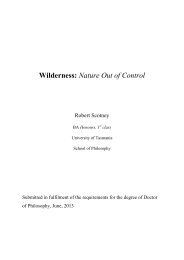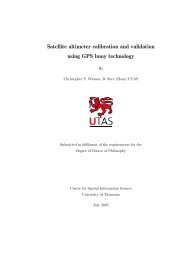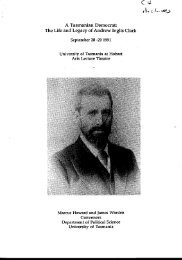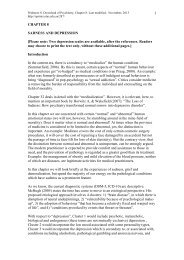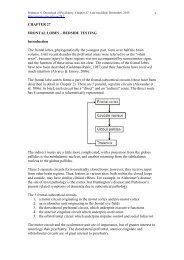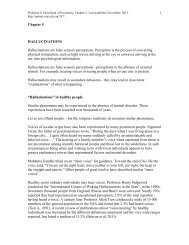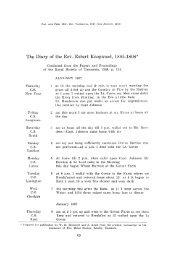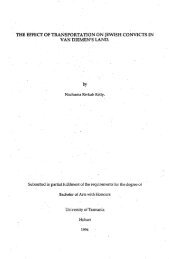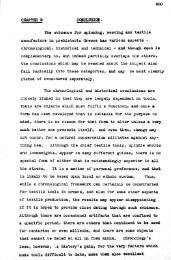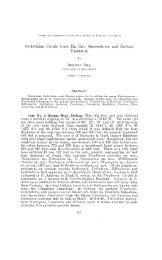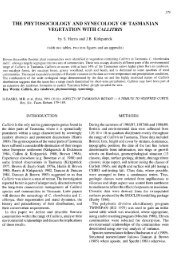A new Mygalomorph Spider belonging to the Genus ... - UTas ePrints
A new Mygalomorph Spider belonging to the Genus ... - UTas ePrints
A new Mygalomorph Spider belonging to the Genus ... - UTas ePrints
Create successful ePaper yourself
Turn your PDF publications into a flip-book with our unique Google optimized e-Paper software.
PAL' & PROt'. ROY. Soc. TA.SMANIA, 19~HJ (17TH AVGUST. 193f3).<br />
131<br />
A <strong>new</strong> <strong>Mygalomorph</strong> <strong>Spider</strong> <strong>belonging</strong> <strong>to</strong> <strong>the</strong><br />
<strong>Genus</strong> Hexa<strong>the</strong>le Ausserer<br />
By<br />
V. V. HICKMAN, B.A., B.Se., C.M.Z.S.<br />
(Read Nth November, IfJ35.)<br />
The genus He:ta<strong>the</strong>le Ausserer (1871) contains only five known<br />
species. The genotype, Hexa<strong>the</strong>le hoehstetteri Auss., was collected<br />
in New Zealand by <strong>the</strong> Novara Expedition. Since <strong>the</strong>n three o<strong>the</strong>r<br />
species have been recorded from that country, namely, H. petrei'j<br />
Goyen (1886), H. hut<strong>to</strong>ni Hogg (1908), and H. webstwri Hog;g (1908).<br />
A fifth species, H. l1wntanus Hickman, was recorded from Tasmania<br />
t)y me in 1926.<br />
In referring <strong>to</strong> H. hochstetteri and H. petre'i'i, Hogg (1901) remarks,<br />
'Except a discrepancy in <strong>the</strong> eyes I can find no difference in <strong>the</strong><br />
descriptions of <strong>the</strong>se two species '. Goyen's description of <strong>the</strong> male<br />
of H. petreii is so brief and vague that it gives little help in establishing<br />
<strong>the</strong> identity of <strong>the</strong> species. His description of <strong>the</strong> female,<br />
however, is definite in regard <strong>to</strong> <strong>the</strong> dentition of <strong>the</strong> chelicerae and<br />
<strong>the</strong> structure of <strong>the</strong> tarsal claws. He states (1886) that <strong>the</strong> groove<br />
of <strong>the</strong> falces has a large number of teeth on each side, and that <strong>the</strong><br />
inferior tarsal claw is 'much bent hut without teeth '. In regard <strong>to</strong><br />
H. hochstettwY'i, AusBerer (1.871) remarks 'die Afterklaue 1St<br />
mehrzahnig', and in his diagram shows <strong>the</strong> inferior tarsal claw of<br />
<strong>the</strong> first pair of legs as having three teeth. Hogg apparently overlooked<br />
<strong>the</strong>se features until 1908, when he received fur<strong>the</strong>r specimens<br />
of <strong>the</strong> genus from New Zealand, and was able <strong>to</strong> recognize as a<br />
<strong>new</strong> Bpecies (H. hat<strong>to</strong>n;) a form which he had previously (1901)<br />
regarded as identical with <strong>the</strong> genotype.<br />
Rainbow (1920, p. 85) has tentatively recorded He;w<strong>the</strong>le hochstetteri<br />
as occurring in Papua, but thinks it quite possible that' <strong>the</strong><br />
specimens may have accidentally found <strong>the</strong>ir way in<strong>to</strong> <strong>the</strong> bottle<br />
of Papuan material '.<br />
E. Simon (1888, p. 222) described a spider from Chili under 'dw<br />
name of Hecca<strong>the</strong>le cinereo-pilosa., but subsequently made it <strong>the</strong> genot.ype<br />
a <strong>new</strong> genus, Scotinoecns (1892).
132 :\ XEW MYGALOMORPH SPIDER<br />
The pn;sent paper gives a synopsis of <strong>the</strong> species of Ii c;vn<strong>the</strong>lc.<br />
followed by a description of a ne\l; species, H. fen<strong>to</strong>n!, from Ta,,·<br />
n):1J1ia.<br />
Family DIPLURIDAJi;<br />
<strong>Genus</strong> Hexa<strong>the</strong>le Ausserer, 1871<br />
'}<br />
KEY TO THE F}JMALES OF TUE SrEcn~s<br />
inferior targal ehrw wHh teeth<br />
Infer-lor tarbal (·law without teeth<br />
TUI:'Hl of<br />
svincs.<br />
Tarsi of<br />
spines.<br />
first ann second pairs of<br />
Cepha[ofborax: black<br />
first and second pairs of<br />
CephalothoTax red-brown<br />
,i. Both rnargiui:5 of chelie0Tal furrovv \iVith teeth<br />
Retromargin without teeth<br />
n,rrnerl with<br />
~J.. "Front median eye::; once <strong>the</strong>il~ JiameLe-r apayt<br />
1i'1:on1. median eyes leRs than <strong>the</strong>ir diameter apart<br />
A bdomen<br />
without pattern<br />
Abrlmnen<br />
with pronoutlcE'd l)attern<br />
OF HBX:\THELE<br />
2<br />
H. mon<strong>to</strong>/f//!U'; H1t2krllan<br />
If. petrch< Goyen<br />
FJ. ?J)eiJsteri Hogg<br />
[}<br />
I-I. lw.itnni Hogg<br />
H . .fen<strong>to</strong>ni, sp.<br />
fHalc.<br />
Holotype.<br />
Hexathde fen<strong>to</strong>l1i, sp. nov.<br />
Total length<br />
ehelicerae and t~pirmerets)<br />
Length of<br />
Breadth of eephalothoT.ax<br />
Length of ahdomen<br />
DreadLh of adbomen<br />
Leg<br />
Pal)}i<br />
2<br />
,Femur<br />
:nU!:1.<br />
4'8<br />
3-H<br />
:)Of)<br />
4'l<br />
2'~"<br />
Patella<br />
Ti.bia<br />
nllH. Hnn.<br />
2'2 8,0<br />
2'0 2'9<br />
]'7<br />
2';~<br />
z·o :~-2<br />
]'4 2-0<br />
MeLatat3UR<br />
tnrn.<br />
;3-6<br />
·j·2<br />
Tarsus<br />
\Vidth of first patella at l\nee' 0-S40 mm, Tibial index 16·1.<br />
'Width of fourth patella a1 knc-E' , 0·:512 mm, Tibial innex 15"6.<br />
Caya.p1lce. Ovate, truncate in front. Rear margin slightly indented.<br />
Surface glabrous exeept for a median longitudinal row of black hairs<br />
extending: from ocular tubercle <strong>to</strong> fovea. Lateral margins fringed,<br />
Ivith coars(e blnck hairs. Radial grooves distinct. Thoracic fovea 3·2<br />
mm. from front margin, very slightly rec\1rved, Cephalic region<br />
high. Clypeu~., equal <strong>to</strong> slightly more than half <strong>the</strong><br />
iiiam(,ter of AMI
V. V, HICKMAN 138<br />
A.- Venti'al view of left<br />
of' maJe. C.- --Ventral<br />
male.<br />
of abdomen<br />
FiR. L --lJr;;I:a<strong>the</strong>le ien<strong>to</strong>ni, sp. ll.<br />
of nude. B.··· l.abium, and maxillae<br />
of left metatarsus first pail' of -of<br />
or male. lij.----8pinnel'ct8 of male. F.<br />
",howinp: pattern.
134 A NEW MYGALOMORPH SPIDER<br />
Eyes. The eye-group is wider than long in ratio 19 : 11. Ocular<br />
tubercle pigmented with black between <strong>the</strong> eyes. In front of <strong>the</strong><br />
eye-group are nine or ten stiff curved bristles. Anterior row of<br />
eyes straight by anterior edges; posterior row recurved. Ratio of<br />
eyes AME : ALE: PME: PLE = 5 : 6 : 3·5 : 6. AME are<br />
separated from each o<strong>the</strong>r by 2/5 of <strong>the</strong>ir diameter and from AL,E<br />
by 1/5 of <strong>the</strong> diameter of <strong>the</strong> AME. The PME are separated from<br />
each o<strong>the</strong>r by 7/5 of <strong>the</strong> diameter of <strong>the</strong> AME. The laterals are<br />
separated by 2/5 of <strong>the</strong> diameter of <strong>the</strong> AME. (Text-fig. 1. D.)<br />
Chelicerae. Basal segment 2·3 mm. long, dark-brown. Dprsal<br />
and retrolateral surfaces glabrous. Front and dorso-prolateral margin<br />
clo<strong>the</strong>d with bristles. Rastellum absent. Fang 2·9mm. long, slender,<br />
sharp, and curved. Promargin of furrow with nine large and three<br />
or four minute black teeth. Retromargin with a scopula, but without<br />
teeth.<br />
Labium. Broader than long. Rounded in front. Clo<strong>the</strong>d with<br />
long hairs and armed with 13 small cuspules. The groove separating<br />
<strong>the</strong> labium from <strong>the</strong> sternum is very shallow and dark-brown.<br />
Maxillae. 1·7 mm. long by 1'0 wide. Provided with a scopula of<br />
fipe 'red hairs and about 38 small cuspules on <strong>the</strong> basal third. (Textfig.<br />
1. B.)<br />
Sternum. Light-brown, shield-shaped, longer than wide in ratio<br />
40 : 38. Thinly clo<strong>the</strong>d with coarse black bristles, and marked with<br />
three pairs of sigilla. The first and second pairs of sigilla are small<br />
and circular, <strong>the</strong> third pair larger and oval, separated from <strong>the</strong><br />
margin by <strong>the</strong>ir length. (Text-fig. 1. B.)<br />
Legs. 4. 1, 2. 3. Light-brown. Clo<strong>the</strong>d with black hairs and<br />
bristles, but without a dGfinite scopula. Trichobothria on all tarsi,<br />
metatarsi, and tibiae. Metatarsi of first pair of legs dark-brown and<br />
sinuous (Text-fig. 1. C). Tibiae normal. Upper tarsal claws with<br />
a row of 7 or 8 teeth crossing <strong>the</strong> claw obliquely. The inferior claw<br />
is small and devoid of teeth.<br />
Palpi. Light-brown, clo<strong>the</strong>d with black hairs and bristles. Genital<br />
bulb pyriform, ending in a short, twisted, lance-shaped style. Tibia<br />
dilated and furnished with numerous coarse bristles on <strong>the</strong> swollen<br />
part. (Text-fig. 1. A.)<br />
Spines.-First leg. Femur: dorsal 1-1-1-1-1-1-1-1, prolateral 1-1,<br />
retrolateral 0, ventral 0. Patella: dorsal 0, prolateral 1-1, retrolateral<br />
0, ventral 2-2. Tibia: dorsal 0, prolateral 1-1, retrolateral 0,<br />
ventral 2-1-2-1-3. Metatarsus: ventral 2-1-3, elsewhere 0. Tarsus:<br />
ventral 1-1, elsewhere 0. Second leg. Femur: dorsal 1-1-1-1-1-1-1,<br />
prolateral 1-1-1-1, retrolateral 1-1-1-1, ventral 0. Patella: dorsal 0,<br />
prolateral 1-1, retrolateral 0, ventral 2r. Tibia: dorsal 0, prolateral<br />
1-1, retrolateral 0, ventral 1-2-1-2-3. Metatarsus: dorsal 1, ventral<br />
2-1-2-1-4, elsewhere 0. Tarsus: dorsal 0, prolateral 1, retrolateral 1-1,<br />
ventral 0. Third leg. Femur: dorsal 2-2-2-2-2, prolateral 1-1, elsewhere<br />
0. Patella: dorsal 0, prolateral 1-2, retrolateral 1-1, ventral
V. V. HICKMAN 135<br />
lr. Tibia: do.rsal 1-1-1, pro.lateral 1-1-1-1-1, retro.lateral 1-1-1, venttral<br />
3-2-1-3. Metatarsus: do.rsal 1, pro.lateral 1-1-1-1-1, retro.<br />
lateral 1-1-1, ventral 2-2-1-3. Tarsus: do.rsal 0, pro.lateral 1-1-1-1,<br />
retro.lateral 1-1-1-1, ventral 1-1. Fourth leg. Femur: do.rsal<br />
2-1-1-1-1-1-1, elsewhere O. Patella: ventral 1r, elsewhere O. Tibia:<br />
do.rsal 1 basal, pro.lateral 1-1, retro.lateral 1-1-1, ventral 3-1-3-3.·<br />
Metatarsus: do.rsal 0, pro.lateral 1-1-1, retro.lateral 1-1-1, ventral<br />
2-1-1-2-1-1-4. Tarsus: dorsal 0, pro.lateral 1-1-1-1-1-1, retro.lateral<br />
1-1-1-1-1~1, ventral 1-1. Palpus. Femur: do.rsal 1-1-1, elsewhere O.<br />
Patella: pro.lateral 1, elsewhere O. Tibia: retro.lateral 1-1-2, elsewhere<br />
O. Tarsus O.<br />
Abdomen. Bro.wn. CIo.<strong>the</strong>d with black bristles anterio.rly and<br />
do.rsally. Sides and ventral surface clo.<strong>the</strong>d with fine black hairs.<br />
Dorsal surface marked with five pairs o.f dark oblique stripes and<br />
a median stripe as in <strong>the</strong> female. (Text-fig. 1. F.)<br />
Spinnerets. Six. Yellowish-bro.wn, clo.<strong>the</strong>d with black hairs. Posterior<br />
pair 3·5 mm. lo.ng, fo.ur-jo.inted abo.ve and three-jo.inted,'belo.w,<br />
separated at <strong>the</strong> base by 1·5 mm. The o.<strong>the</strong>r fo.ur spinnerets are in<br />
a straight line immediately in fro.nt o.f <strong>the</strong> Po.sterio.r pair. The<br />
outer pair are two.-jo.inted and 1'0 mm. Io.ng. The inner pair are<br />
one-jointed and 0'6 mm. lo.ng. The inner pair are separated fro.m<br />
each o.<strong>the</strong>r by 0'7 mm. Anal tubercle, yello.wish, very large, and<br />
projecting between <strong>the</strong> Po.sterio.r spinnerets. (Text-fig. 1. E.)<br />
Female.<br />
Allo.type.<br />
Total length (excluding chelicerae and spinneret")<br />
Length of cephalothorax .<br />
Breadth of cephalothorax<br />
Length of abdomen .... . .. .<br />
Breadth of abdomen . ... . .. .<br />
Femur Patella Tibia<br />
mm. mm. mm.<br />
Leg 1 4·6 2·3 2'8<br />
2 3·9 2,2 2'4<br />
3 3·4 1·8 1·8<br />
4 4·6 2·3 2'8<br />
Palpi .... .... 2'8 1·4 1·9<br />
Metatarsus<br />
mm.<br />
2'8<br />
2·6<br />
2·5<br />
3'1<br />
Tarsus<br />
mm.<br />
2'0<br />
1·8<br />
1'7<br />
1'7<br />
1'8<br />
19.<br />
Width of first patella at 'knee J 0'986 mm. Tibial index<br />
Width of fourth patella at • knee' 0'870 mm. Tibial index 17.<br />
mm.<br />
15·0<br />
7·0<br />
4·8<br />
8·0<br />
0·8<br />
Total<br />
mm.<br />
14'5<br />
12·9<br />
11·2<br />
14·5<br />
7·9<br />
Carapace. Ovate, chestnut-bro.wn. Fro.nt margin truncate, rear<br />
margin indented. Sides fringed with a few sho.rt hairs. Radial<br />
gro.o.ves distinct and slightly darker in co.Io.ur than <strong>the</strong> rest o.f <strong>the</strong><br />
carapace. Tho.racic fo.vea deep and almo.st straight. Surface o.f<br />
carapace smo.o.th and glabro.us, except fo.r a median ro.w of black<br />
hairs extending fro.m eye-gro.up <strong>to</strong>. fo.vea. Clypeus narro.w. Articular<br />
membrane between <strong>the</strong> carapace and chelicerae suffused with black.<br />
Eyes. Eye-tubercle mo.derately high. Eye-gro.up wider than Io.ng<br />
in ratio 23 : 12. Space between <strong>the</strong> eyes black. A group o.f abo.ut<br />
twelve bristles in fro.nt o.f <strong>the</strong> eyes and a smaller gro.up between <strong>the</strong>
136 A NEW MYGALOMORPH SPIDER<br />
posterior median eyes. Anterior row of eyes straight by anterior<br />
edges, posterior TOW recurved. Ratio of eyes AMI:
V. V. HICKMAN<br />
Six. Posterior pair 4·3 nun. long, four-jointed on dorsal<br />
surface, three-jointed on ventral surface. The two anterior pairs<br />
are short and almost in <strong>the</strong> same transverse line, immediately in<br />
front of <strong>the</strong> posterior p



